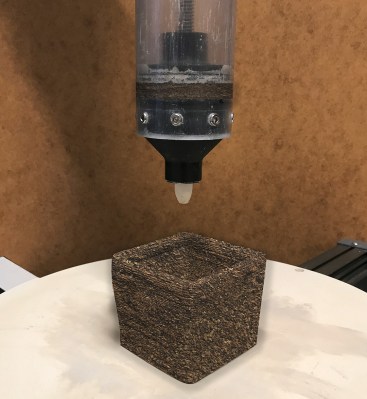There’s a Fungus Among Us that Absorbs Sound and Does Much More

Ding dong, the office is dead — at least we hope it is. We miss some of the people, the popcorn machine, and the printer most of all, but we say good riddance to the collective noise. Thankfully, we never had to suffer in an open office.
For many of us, yours truly included, home has become the place where we spend approximately 95% of our time. Home is now an all-purpose space for work, play, and everything in between, like anxiety-induced online shopping. But unless you live alone in a secluded area and/or a concrete bunker, there are plenty of sound-based distractions all day and night that emanate from both inside and outside the house. Headphones are a decent solution, but wearing them isn’t always practical and gets old after a while. Wouldn’t it be nice to be able to print your own customized sound absorbers and stick them on the walls?

Sure, you can already buy prefabricated panels, or make your own out of fiberglass and fabric, or even just staple some egg crate foam to the wall and call it a day. But the problem is that most modern sound-absorbing materials like mineral wool, cellulose, fiberglass, and convoluted foam aren’t sustainable, nor are they easy to recycle.
A research institute in Germany is working to develop fungal-based sound absorbers that are entirely organic. The concept is based around mycelium, the wide-spreading underground root network of various fungi that is made up of fine, filament-like fibers called hyphae.
The team is led by Julia Krayer, a project manager at the Fraunhofer Institute in Oberhausen, Germany who has long been working with biomaterials. Julia and the team grow their own hyphae in the lab, and mix it with a plant-based substrate that’s made of straw, wood, and food production waste.
The mixture is 3D printed in the desired shape, and then the hyphae go to work, spreading throughout the substrate and solidifying the structure in the process. Once the hyphae start poking through the surface, the print is dried in a kiln to kill off the fungus. The resulting material has open cell walls that absorb sound just as well as their synthetic counterparts, and may potentially surpass them in the future given the nature of 3D printing.
There’s No Ceiling to the Flexibility of Mycelium
Okay, so printing your own hexagonal or other fun-shaped sound absorbers might be a bit far off, unless you have access to a kiln or can dedicate an oven to drying your home-brewed acoustic panels. Mycelium begins to decompose around 435 °F (225 °C), so a regular kitchen oven wouldn’t be completely out of the question. But you probably wouldn’t want to use it for food after that.
As we’ve seen over the years, mycelium is quite the multi-purpose material. It can be used as an alternative to fiberglass insulation in walls and attics, or molded into canoes that can still produce fruiting bodies. And companies like Adidas are trying to use mycelium as a cruelty-free and sustainable alternative to leather.
A company called Ecovative Design are taking things a bit further by making biodegradable alternatives to plastic and packaging as well as leather, cosmetic sponges, insulating material for gloves, and foam for footwear. Would you wear mushroom leather shoes or warm your fingers in a fungal fashion statement? They might grow on you. Let us know what you think in the comments.
Post a Comment